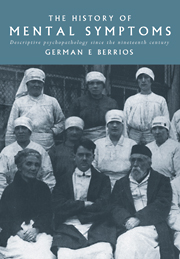Book contents
- Frontmatter
- Contents
- PREFACE
- ACKNOWLEDGEMENTS
- INTRODUCTION
- PART I The object of inquiry
- PART II Cognition and consciousness
- PART III Mood and emotions
- CHAPTER 11 Anxiety and cognate disorders
- CHAPTER 12 Affect and its disorders
- CHAPTER 13 The anhedonias
- PART IV Volition and action
- PART V Miscellany
- REFERENCES
- NAME INDEX
- SUBJECT INDEX
CHAPTER 11 - Anxiety and cognate disorders
from PART III - Mood and emotions
Published online by Cambridge University Press: 08 January 2010
- Frontmatter
- Contents
- PREFACE
- ACKNOWLEDGEMENTS
- INTRODUCTION
- PART I The object of inquiry
- PART II Cognition and consciousness
- PART III Mood and emotions
- CHAPTER 11 Anxiety and cognate disorders
- CHAPTER 12 Affect and its disorders
- CHAPTER 13 The anhedonias
- PART IV Volition and action
- PART V Miscellany
- REFERENCES
- NAME INDEX
- SUBJECT INDEX
Summary
Whilst the history of the neuroses in general, and that of hysteria, hypochondria and obsessive-compulsive disorder in particular, have received historical attention, the evolution of what is nowadays known as ‘generalized anxiety disorder’, ‘panic disorder’, and ‘phobia’ has been neglected. This may be due to their relative newness; or to the fact that the historical model used to account for the traditional nervous disorders is inappropriate for the new neuroses.
This does not mean that the individual symptoms now included under the ‘anxiety disorders’ are themselves new. Indeed, they have been known since time immemorial; the only difference being that, in the past, they were reported in different social and medical contexts. For example, during the eighteenth century such symptoms were considered to be specific diseases or, less frequently, included under the syndromic domain of other diseases. The novelty has been that, during the 1890s, these symptoms were rescued from their earlier niches and put together into what was then claimed were independent clinical conditions. The notion that these symptoms could all be the manifestation of a unitary construct called ‘anxiety’ is also new, at least is alien to pre-Freudian psychiatry. The historical and ideological factors that led to this state of affairs need disentangling.
By the 1860s, and before the final synthesis took place, such symptoms could be found in clinical realms as disparate as cardiovascular, inner ear, gastrointestinal, or neurological medicine. Basically, each symptom seems to have been taken at face value and treated as a real ‘physical’ complaint. This is one reason why they were mostly reported in medical (not psychiatric) journals.
- Type
- Chapter
- Information
- The History of Mental SymptomsDescriptive Psychopathology since the Nineteenth Century, pp. 263 - 288Publisher: Cambridge University PressPrint publication year: 1996
- 1
- Cited by

